River Flood Risk Assessment in Communities of the Peruvian Andes: A Semiquantitative Application for Disaster Prevention
Abstract
:1. Introduction
2. Materials and Methods
2.1. Study Area
2.2. Data Collection
2.3. Methodology
3. Results
3.1. River Flood Hazard Levels
3.2. Levels of Vulnerability to River Floods
3.3. River Flood Risk Levels
4. Discussion
5. Conclusions
Author Contributions
Funding
Institutional Review Board Statement
Informed Consent Statement
Data Availability Statement
Conflicts of Interest
References
- Ozturk, D.; Yilmaz, I.; Kirbas, U. Flood hazard assessment using AHP in Corum, Turkey. Tecnol. Cienc. Agua 2021, 12, 379–415. [Google Scholar] [CrossRef]
- Bucogen, G.; Piccolo, M.; Bohn, V. Estimación de la Susceptibilidad a inundaciones en la cuenca inferior de Río Negro, Argentina. Finisterra 2021, 56, 51–70. [Google Scholar] [CrossRef]
- Degeai, J.P.; Blanchemanche, P.; Tavenne, L.; Tillier, M.; Bohbot, H.; Devillers, B.; Dezileau, L. River flooding on the French Mediterranean coast and its relation to climate and land use change over the past two millennia. CATENA 2022, 219, 106623. [Google Scholar] [CrossRef]
- de Albuquerque, J.P.; Anderson, L.; Calvillo, N.; Cattino, M.; Clarke, A.; Cunha, M.A.; Degrossi, L.C.; Garde-Hansen, J.; Klonner, C.; Lima-Silva, F.; et al. Dialogic data innovations for sustainability transformations and flood resilience: The case for Waterproofing Data. SSRN Electron. J. 2022, 82, 102730. [Google Scholar] [CrossRef]
- Cajigal, E.; Maldonado, A. Metodología para el análisis de vulnerabilidad ante inundaciones. Un ejercicio emergente ante el cambio climático. Econ. Soc. Territ. 2019, 19, 543–574. [Google Scholar] [CrossRef]
- Yu, J.; Zou, L.; Xia, J.; Zhang, Y.; Zuo, L.; Li, X. Investigating the spatial-temporal changes of flood events across the Yangtze River Basin, China: Identification, spatial heterogeneity, and dominant impact factors. J. Hydrol. 2023, 621, 129503. [Google Scholar] [CrossRef]
- Zhang, C.; Sun, F.; Sharma, S.; Zeng, P.; Mejia, A.; Lyu, Y.; Gao, J.; Zhou, R.; Che, Y. Projecting multi-attribute flood regime changes for the Yangtze River basin. J. Hydrol. 2023, 617, 128846. [Google Scholar] [CrossRef]
- Guo, X.; Cheng, J.; Yin, C.; Li, Q.; Chen, R.; Fang, J. The extraordinary Zhengzhou flood of 7/20, 2021: How extreme weather and human response compounding to the disaster. Cities 2023, 134, 104168. [Google Scholar] [CrossRef]
- Loc, H.H.; Emadzadeh, A.; Park, E.; Nontikansak, P.; Deo, R.C. The Great 2011 Thailand flood disaster revisited: Could it have been mitigated by different dam operations based on better weather forecasts? Environ. Res. 2023, 216, 114493. [Google Scholar] [CrossRef] [PubMed]
- Cai, T.; Li, X.; Ding, X.; Wang, J.; Zhan, J. Flood risk assessment based on hydrodynamic model and fuzzy comprehensive evaluation with GIS technique. Int. J. Disaster Risk Reduct. 2019, 35, 101077. [Google Scholar] [CrossRef]
- Garnica, R.; Alcántara, I. Riesgos por inundación asociados a eventos de precipitación extraordinaria en el curso bajo del río Tecolutla, Veracruz. Investig. Geográficas 2004, 55, 23–45. [Google Scholar]
- Hernández, R.; Barrios, H.; Ramírez, A. Análisis de riesgo por inundación: Metodología y aplicación a la cuenca Atemajac. Tecnol. Cienc. Agua 2017, 8, 5–25. [Google Scholar] [CrossRef]
- Senamhi (Servicio Nacional de Meteorología e Hidrología del Perú). Inventario de datos de eventos de inundaciones del Perú. Estud. Final 2022, 6, 128. [Google Scholar]
- ONU. Marco de Sendai Para la Reducción del Riesgo de Desastres 2015–2030; Secretario General Para La Reducción Del Riesgo De Desastres SGRRD-ONU; UNISDR: Sendai, Japan, 2015. [Google Scholar]
- Vilchez, M.; Ochoa, M. Zonas Críticas Por Peligros Geológicos en la Región Huancavelica; Ingemment: Huancavelica, Peru, 2014. [Google Scholar]
- Beltramino, T. Los desastres y la visibilización de los riesgos. Las inundaciones en Santa Fe, Argentina. Bitácora Urbano Territ. 2019, 29, 165–173. [Google Scholar] [CrossRef]
- Nahin, K.T.K.; Islam, S.B.; Mahmud, S.; Hossain, I. Flood vulnerability assessment in the Jamuna river floodplain using multi-criteria decision analysis: A case study in Jamalpur district, Bangladesh. Heliyon 2023, 9, e14520. [Google Scholar] [CrossRef]
- Diario Oficial El Peruano. 564237 Normas Legales. El Peruano, 22 October 2015; 1–3. [Google Scholar]
- Oficina Para la Coordinación de Asuntos Humanitarios (OCHA). PERÚ: Inundaciones y Deslizamientos; OCHA: New York, NY, USA, 2023; pp. 1–7. [Google Scholar]
- Cano, T. Estimación del Riesgo de Desastres en la Subcuenca Baja del Río Shullcas Zona Urbana de la Ciudad de Huancayo; UNCP: Huancayo, Peru, 2019. [Google Scholar]
- Zapperi, P. Análisis de la incorporación del riesgo de inundación en la normativa de ordenamiento territorial de Argentina. Investig. Geogr. 2018, 70, 71–90. [Google Scholar] [CrossRef]
- Jia, H.; Chen, F.; Pan, D.; Du, E.; Wang, L.; Wang, N.; Yang, A. Flood risk management in the Yangtze River basin —Comparison of 1998 and 2020 events. Int. J. Disaster Risk Reduct. 2022, 68, 102724. [Google Scholar] [CrossRef]
- Wan, H.; Abdullah, J.; Abdul, K.; Muhammad, N. Urban flash flood index based on historical rainfall events. Sustain. Cities Soc. 2020, 56, 102088. [Google Scholar] [CrossRef]
- Valencia, N.; Pariona, A.; Huamán, M.; Miranda, F.; Quintanilla, S.; Gonzáles, A. Seroprevalencia de fasciolosis en escolares y en ganado vacuno en la provincia de Huancavelica, Perú. Rev. Peru Med. Exp. Salud Publica 2005, 22, 96–102. [Google Scholar]
- Silvera, F. Innovación Productiva-Comercial de Pequeños Productores(as) de Quinua en Comunidades del VRAEM- Huancavelica y Aledaños; Fondo Empleo: Huancavelica, Peru, 2018. [Google Scholar]
- Quispe, E. Aspectos Socio-Culturales del Proceso de Urbanización en el Poblado de Izcuchaca. Bachelor’s Thesis, Universidad Nacional de San Antonio de Abad del Cuzco, Cuzco, Peru, 2020. [Google Scholar]
- Cardenas, R.; Meza, N. Determinantes Sociales de la Salud y Anemia Ferropenica en Niños(as) Menores de 5 Años del Distrito de Izcuchaca, Huancavelica –2019. 2019. Available online: http://repositorio.unac.edu.pe/handle/20.500.12952/5378 (accessed on 10 April 2023).
- Aliaga, E. Factores que Influyen en Conflicto Social en Torno al Proyecto Mejoramiento de Los Servicios Básicos en el Distrito de Izcuchaca—Huancavelica 2017. Bachelor’s Thesis, Universidad Continental, Huancayo, Peru, 2018. [Google Scholar]
- Fernández, B. Informe Preliminar de la Inspección Técnica Geológica en el Cerro Hatun Rumi; Ingemment: Huancavelica, Peru, 2017. [Google Scholar]
- Mori, A. Influencia de las Tensiones Geostaticas en la Estabilidad de Talud Carreta Acostambo Izcuchaca. Bachelor’s Thesis, Universidad Peruana Los Andes, Huancayo, Peru, 2020. [Google Scholar]
- Rojas, A. Evaluación del Estado Situacional del Pavimento Flexible de la vía Principal Tramo Huancavelica—Izcuchaca, en la Provincia de Huancavelica, 2018. 2021. Available online: https://hdl.handle.net/20.500.12692/76522 (accessed on 11 April 2023).
- Moreno, J. El Proceso Análitico Jerárquico (AHP). Fundamentos, metodologías y aplicaciones. Recta Monográfico 2002, 1, 21–53. [Google Scholar]
- Sun, R.; Gong, Z.; Gao, G.; Shah, A.A. Comparative analysis of Multi-Criteria Decision-Making methods for flood disaster risk in the Yangtze River Delta. Int. J. Disaster Risk Reduct. 2020, 51, 101768. [Google Scholar] [CrossRef]
- De Brito, M.M.; Evers, M. Multi-criteria decision-making for flood risk management: A survey of the current state of the art. Nat. Hazards Earth Syst. Sci. 2016, 16, 1019–1033. [Google Scholar] [CrossRef]
- Hochrainer-Stigler, S.; Lorant, A. Evaluating Partnerships to Enhance Disaster Risk Management using Multi-Criteria Analysis: An Application at the Pan-European Level. In Environmental Management; Springer: New York, NY, USA, 2018; Volume 61, pp. 24–33. [Google Scholar] [CrossRef]
- Leyva, C.J.; Gatell, A.A.; Leyva, I.A. Proceso Analítico Jerárquico. Herramienta para la gestión del ordenamiento urbano-ambiental en el eje Luaces de Camagüey. Rev. Científica Arquit. Urban. 2019, 40, 43–57. Available online: https://rau.cujae.edu.cu/index.php/revistaau/article/view/530 (accessed on 13 April 2023).
- Panez, P. Evaluación del Potencial Ecoturistico del Distrito de Izcuchaca-Huancavelica. Bachelor’s Thesis, Universidad Nacional del Centro del Perú, Huancayo, Peru, 2019. [Google Scholar]
- Hernández, R. Metodologia de la Investigacion; Mc Graw-Hill: Mexico City, Mexico, 2014; Volume 4. [Google Scholar]
- Junior, R.R.; de Carvalho, M.M. Understanding the impact of project risk management on project performance: An empirical study. J. Technol. Manag. Innov. 2013, 8, 64–78. [Google Scholar] [CrossRef]
- Liberatore, M.J.; Nydick, R.L. The analytic hierarchy process in medical and health care decision making: A literature review. Eur. J. Oper. Res. 2008, 189, 194–207. [Google Scholar] [CrossRef]
- Vaidya, O.S.; Kumar, S. Analytic hierarchy process: An overview of applications. Eur. J. Oper. Res. 2006, 169, 1–29. [Google Scholar] [CrossRef]
- Marzo, E.; Serra, C.; Valerino, P.; Ramírez, W.; Wilson, D. Analysis of risks for sanitary endemic disasters in the english equines. REDVET Rev. Electrónica Vet. 2010, 11, 1695–7504. [Google Scholar]
- Falavigna, G.P.; Iescheck, A.L.; de Souza, S.F. Obstacles risk classification model in aerodromes protection zones using the multi-criteria decision analysis ahp. Bol. Ciencias Geod. 2021, 27, 4. [Google Scholar] [CrossRef]
- Contardo, J.I.; Curihuinca, M.C.; Vargas, G.E.; Tello, S.P. Revelando el riesgo sísmico en el piedemonte de Santiago, Chile. Análisis multicriterio para la determinación de vulnerabilidad en la Falla San Ramón (FSR). Rev. De Geogr. Norte Gd. 2022, 81, 331–359. [Google Scholar] [CrossRef]
- Ávila, J.R.; Romero, A.G.; García, J.L.; Delgado, M.L. Análisis multicriterio para la delimitación de una región árida del centro de México. Acta Univ. 2015, 25, 11–25. [Google Scholar] [CrossRef]
- Gómez, J.; Orejuela, O. El proceso de análisis jerárquico y la toma de decisiones multicriterio. Red Rev. Científicas América Lat. el Caribe, España y Port. 2008, 14, 247–252. Available online: https://www.redalyc.org/pdf/849/84920503044.pdf (accessed on 13 April 2023).
- Ramírez, M. El método de jerarquías analíticas de Saaty en la ponderación de variables. Comun. Cient. Y Tecnol. 2004, 4, 1–7. [Google Scholar]
- Flores, P.; Ayala, I.A. Susceptibility to shallow landslides of soil in the municipality of Temoaya, Mexico: Multicriteria analysis. Investig. Geogr. 2012, 77, 31–47. [Google Scholar] [CrossRef]
- CENEPRED. Manual Para la Evaluación de Riesgos Originados por Fenómenos Naturales. 2014. Available online: http://www.sigpad.gov.co/sigpad/paginas_detalle.aspx?idp=112 (accessed on 13 April 2023).
- Cáceres, G. La metodología de encuesta. Técnicas Investig. En Soc. Cult. Y Comun. 1998, 33–73. Available online: https://biblioteca.marco.edu.mx/files/metodologia_encuestas.pdf (accessed on 13 April 2023).
- SIGRID. Available online: https://cdn.www.gob.pe/uploads/document/file/3989288/PLAN%20DE%20PREVENCI%C3%93N%20Y%20REDUCCI%C3%93N%20DE%20RIESGO%20DE%20DESASTRES%202022-2026.pdf (accessed on 13 April 2023).
- SIGRID. Movimientos en Masa Ante Lluvias Asociadas; 2023; Available online: https://sigrid.cenepred.gob.pe/sigridv3/storage/biblioteca//16310_escenario-de-riesgo-por-inundaciones-y-movimientos-en-masa-ante-lluvias-asociadas-al-fenomeno-el-nino-actualizado-al-15-de-mayo-2023.pdf (accessed on 13 April 2023).
- SIGRID. 16334 Plan de Prevencion y Reduccion de Riesgo de Desastres ante Inundacion Pluvial y Movimientos en Masa del Distrito de Huasta 2023–2025. Available online: https://sigrid.cenepred.gob.pe/sigridv3/documento/16334 (accessed on 13 April 2023).
- Hernández, J.; Vieyra, A. Riesgo por inundaciones en asentamientos precarios del periurbano. Morelia, una ciudad media mexicana. ¿El desastre nace o se hace? Rev. De Geogr. Norte Gd. 2010, 47, 45–62. [Google Scholar] [CrossRef]
- Borzi, G.; Cellone, F.; Tanjal, C.; Melendi, E.; Carol, E. Methodological proposal for the study of floods in plains areas with a lack of information. DYNA 2020, 87, 221–228. [Google Scholar] [CrossRef]
- Sahraei, R.; Kanani-Sadat, Y.; Safari, A.; Homayouni, S. Flood Susceptibility Modelling Using Geospatial-Based Multicriteria Decision Making in Large Scale Areas. ISPRS Ann. Photogramm. Remote Sens. Spat. Inf. Sci. 2023, 10, 677–683. [Google Scholar] [CrossRef]
- Weday, M.A.; Tabor, K.W.; Gemeda, D.O. Flood hazards and risk mapping using geospatial technologies in Jimma City, southwestern Ethiopia. Heliyon 2023, 9, e14617. [Google Scholar] [CrossRef]
- Poma, M. Evaluación del Peligro por Inundación Pluvial de la Quebrada Santa Cecilia, Huamanga, Ayacucho, 2020; Universidad Cesar Vallejo: Lima, Peru, 2020. [Google Scholar]
- Li, Z.; Tang, X.; Li, L.; Chu, Y.; Wang, X.; Yang, D. GIS-based risk assessment of flood disaster in the Lijiang River Basin. Sci. Rep. 2023, 13, 6160. [Google Scholar] [CrossRef]
- Osman, S.A.; Das, J. GIS-based flood risk assessment using multi-criteria decision analysis of Shebelle River Basin in southern Somalia. SN Appl. Sci. 2023, 5, 134. [Google Scholar] [CrossRef]
- Ludwig, L.; Mattedi, M.A. The information and communication technologies in the risk management of social and environmental disasters. Ambiente Soc. 2018, 21. [Google Scholar] [CrossRef]
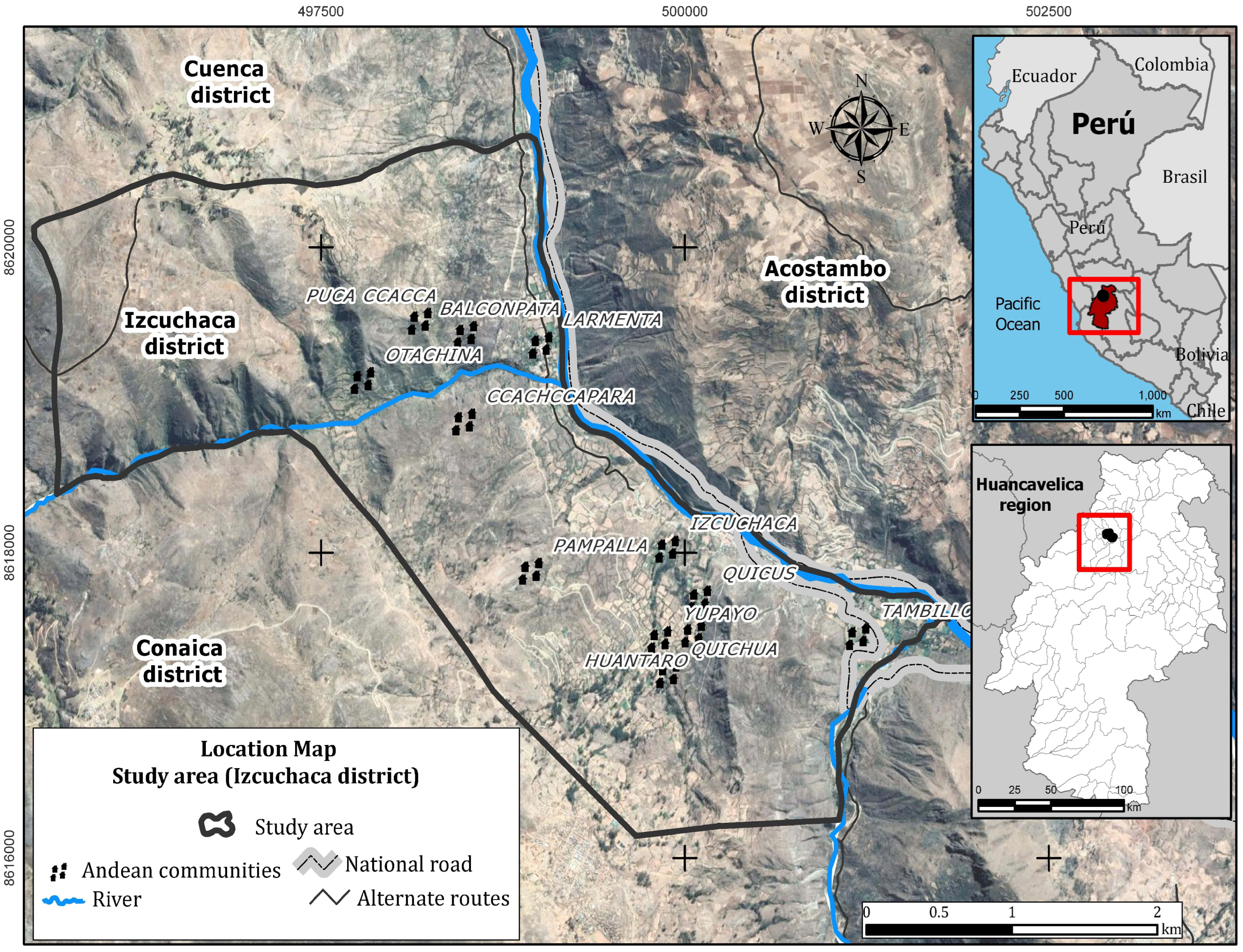
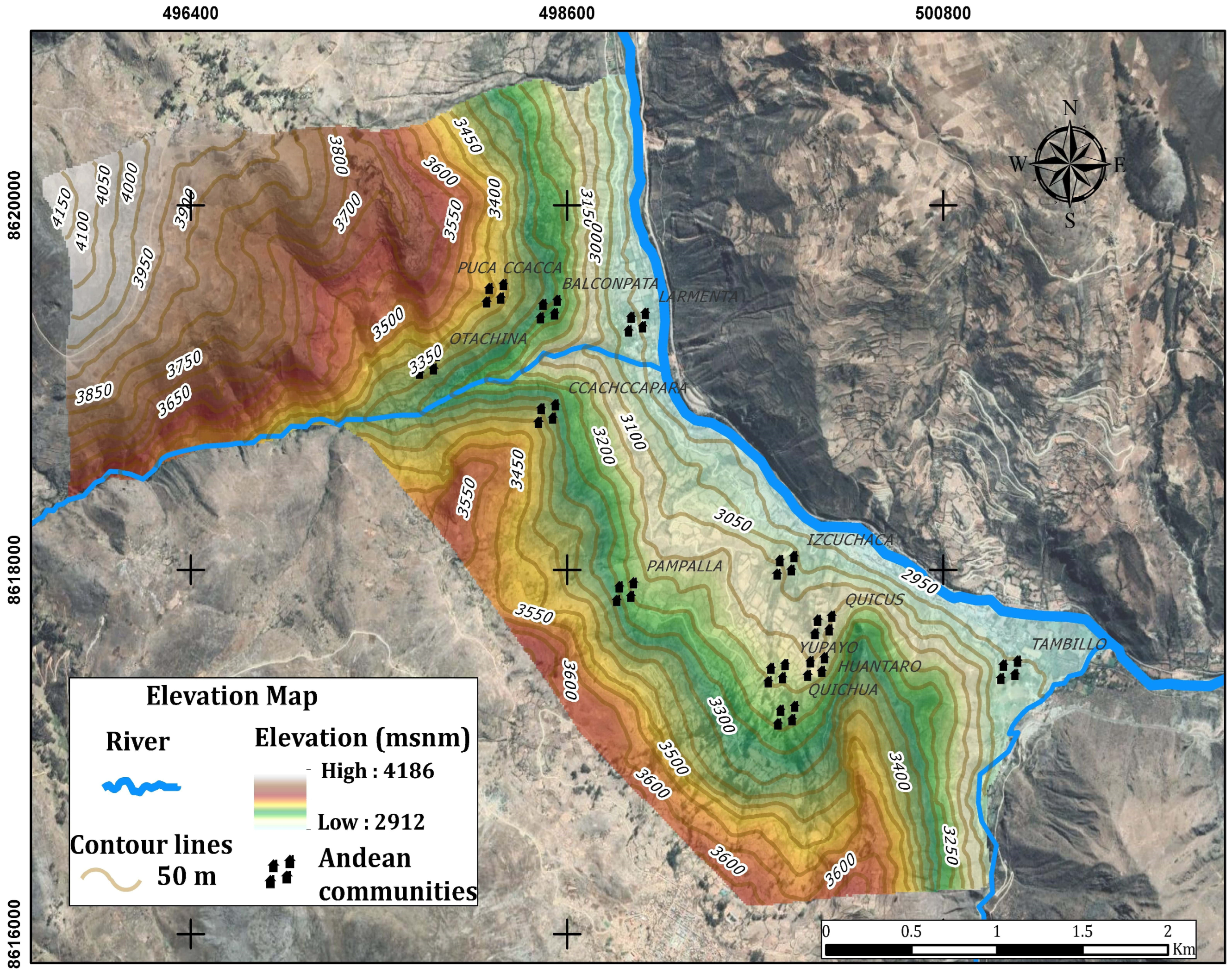
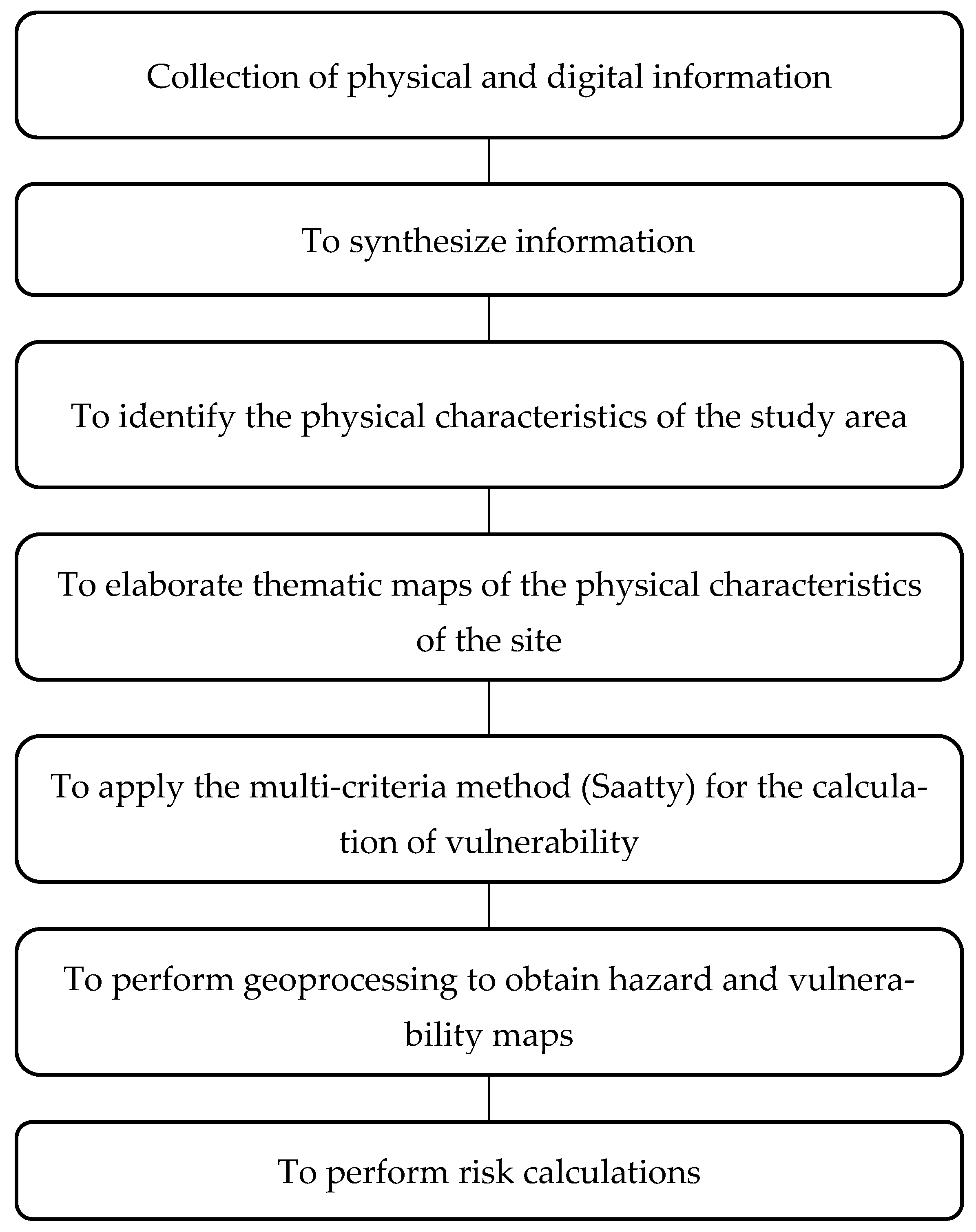
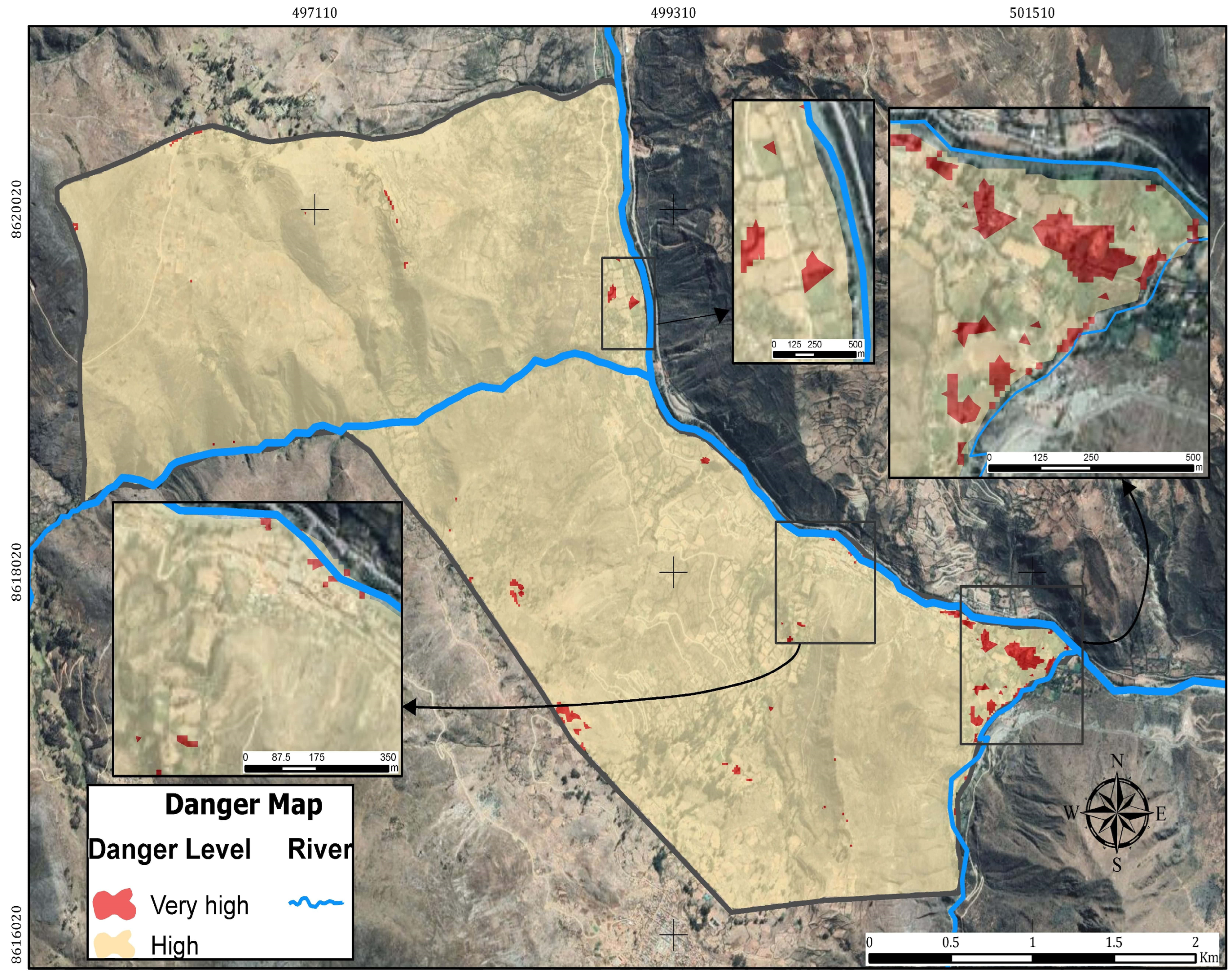
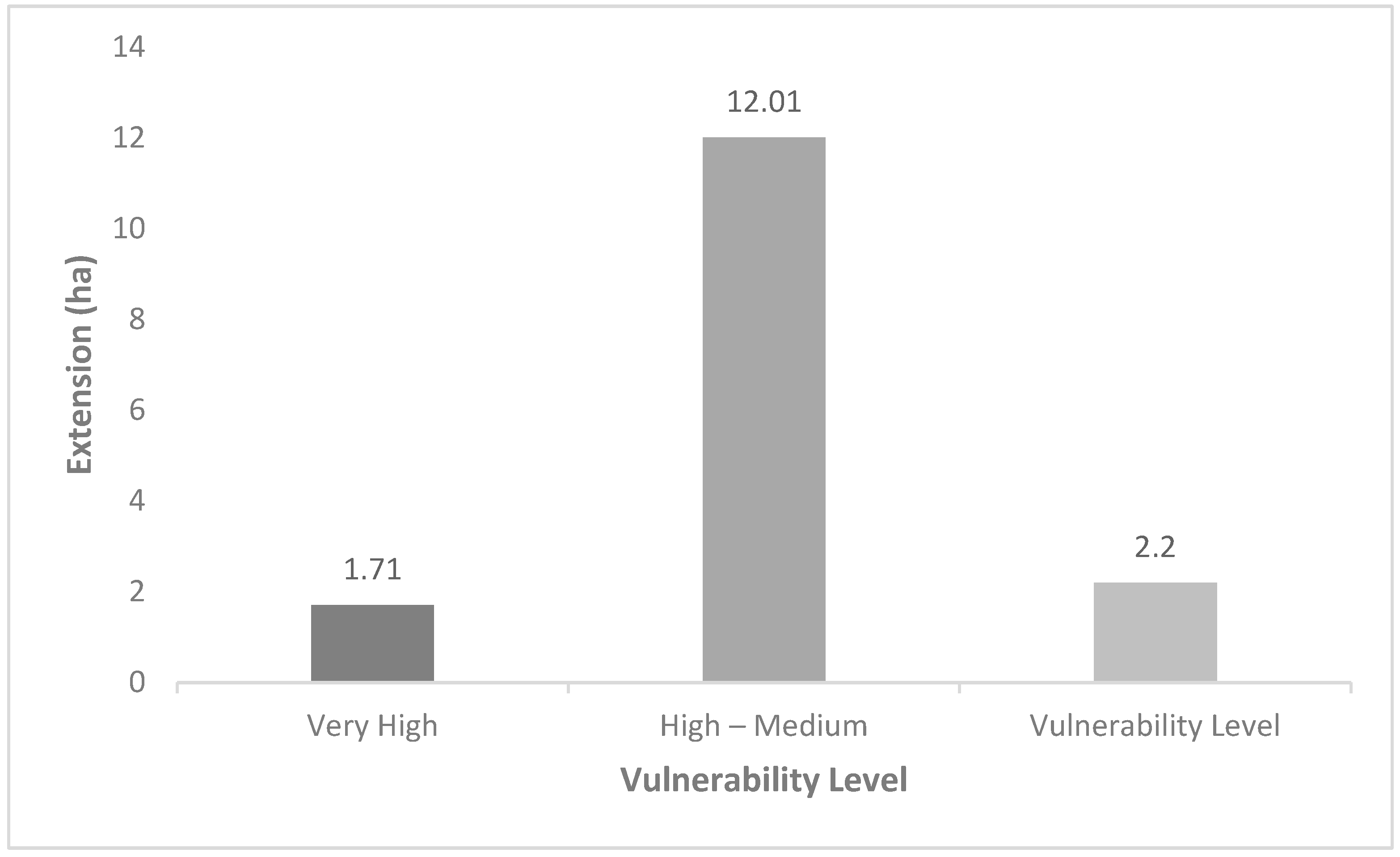
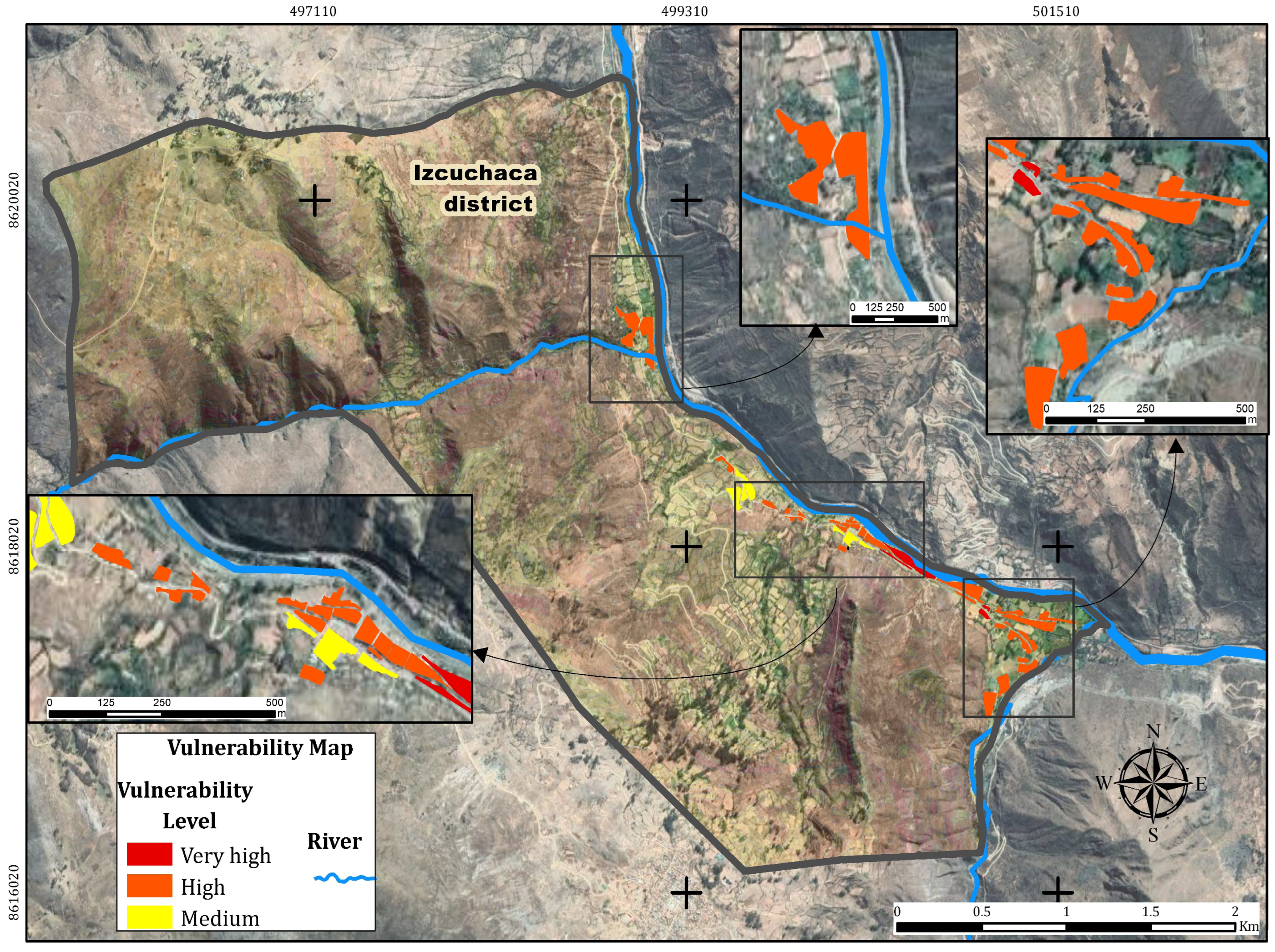
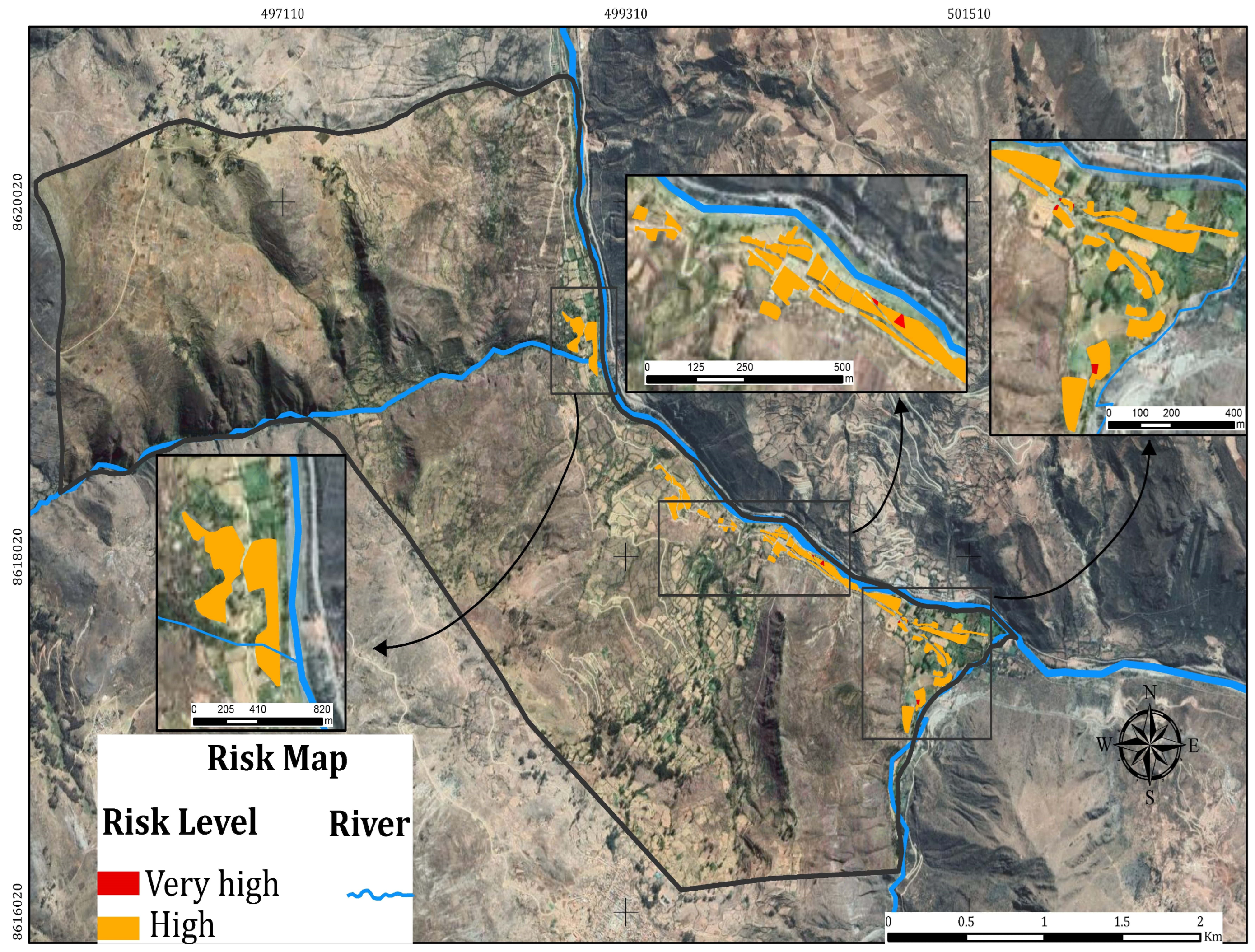
| Criteria | Values * |
|---|---|
| Equal importance | 1 |
| Moderate importance of one variable over another | 3 |
| Strong importance of one variable over another | 5 |
| Very strong importance of one variable over another | 7 |
| Extremely strong importance of one variable over another | 9 |
| Intermediate comparison values | 2, 4, 6, 8 |
| Range | Area km2 | Area ha | % | Level of Danger | ||||
|---|---|---|---|---|---|---|---|---|
| 0.268 | ≤ | P1 | < | 0.480 | 0.09 | 8.90 | 0.74 | Very High |
| 0.142 | ≤ | P | < | 0.268 | 11.95 | 1195.26 | 99.26 | High |
| 0.076 | ≤ | P | < | 0.142 | 0 | 0 | 0 | Medium |
| 0.034 | ≤ | P | < | 0.076 | 0 | 0 | 0 | Low |
| Total | 12.04 | 1204.16 | 100 | |||||
| Range | Area ha | Area km2 | % | Properties | Vulnerability Levels | ||
|---|---|---|---|---|---|---|---|
| 0.279 | ≤ V1 ≤ | 0.456 | 1.71 | 0.017 | 10.8 | 2 | Very High |
| 0.144 | ≤ V < | 0.279 | 12.01 | 0.120 | 75.4 | 24 | High |
| 0.080 | ≤ V < | 0.144 | 2.20 | 0.022 | 13.8 | 5 | Medium |
| 0.039 | ≤ V < | 0.080 | 0 | 0 | 0 | 0 | Low |
| Total | 15.93 | 0.16 | 100 | 31 | |||
| Range | Area ha | Area km2 | % | Risk Level | ||
|---|---|---|---|---|---|---|
| 0.075 | ≤ R1 ≤ | 0.219 | 0.14 | 0.001 | 0.85 | Very High |
| 0.021 | ≤ R < | 0.075 | 15.73 | 0.16 | 99.15 | High |
| 0.006 | ≤ R < | 0.021 | 0 | 0 | 0 | Medium |
| 0.001 | ≤ R < | 0.006 | 0 | 0 | 0 | Low |
| Total | 15.87 | 0.16 | 100 | |||
Disclaimer/Publisher’s Note: The statements, opinions and data contained in all publications are solely those of the individual author(s) and contributor(s) and not of MDPI and/or the editor(s). MDPI and/or the editor(s) disclaim responsibility for any injury to people or property resulting from any ideas, methods, instructions or products referred to in the content. |
© 2023 by the authors. Licensee MDPI, Basel, Switzerland. This article is an open access article distributed under the terms and conditions of the Creative Commons Attribution (CC BY) license (https://creativecommons.org/licenses/by/4.0/).
Share and Cite
Ccopi-Trucios, D.; Barzola-Rojas, B.; Ruiz-Soto, S.; Gabriel-Campos, E.; Ortega-Quispe, K.; Cordova-Buiza, F. River Flood Risk Assessment in Communities of the Peruvian Andes: A Semiquantitative Application for Disaster Prevention. Sustainability 2023, 15, 13768. https://doi.org/10.3390/su151813768
Ccopi-Trucios D, Barzola-Rojas B, Ruiz-Soto S, Gabriel-Campos E, Ortega-Quispe K, Cordova-Buiza F. River Flood Risk Assessment in Communities of the Peruvian Andes: A Semiquantitative Application for Disaster Prevention. Sustainability. 2023; 15(18):13768. https://doi.org/10.3390/su151813768
Chicago/Turabian StyleCcopi-Trucios, Dennis, Brissette Barzola-Rojas, Sheyla Ruiz-Soto, Edwin Gabriel-Campos, Kevin Ortega-Quispe, and Franklin Cordova-Buiza. 2023. "River Flood Risk Assessment in Communities of the Peruvian Andes: A Semiquantitative Application for Disaster Prevention" Sustainability 15, no. 18: 13768. https://doi.org/10.3390/su151813768
APA StyleCcopi-Trucios, D., Barzola-Rojas, B., Ruiz-Soto, S., Gabriel-Campos, E., Ortega-Quispe, K., & Cordova-Buiza, F. (2023). River Flood Risk Assessment in Communities of the Peruvian Andes: A Semiquantitative Application for Disaster Prevention. Sustainability, 15(18), 13768. https://doi.org/10.3390/su151813768








